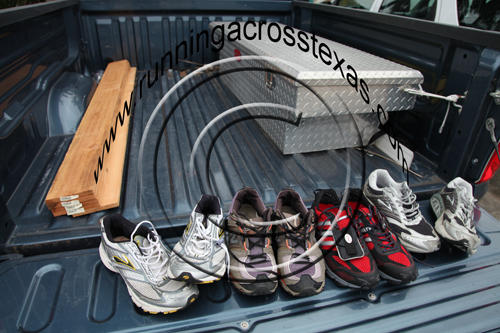Running and Friendly Links
Avoid Sports Injuries with Correctly Fitted Running Shoes
Advice for Over-Pronators, Over-Supinators, and Neutral Runners


A recent copy of Runner’s World magazine ran this statement, “You don't absolutely, positively need a new pair of running shoes when you begin running. You can run in your comfortable cross-trainers, sneakers, or walking shoes.”
What’s up with that? Walking shoes you say? I must respectfully, absolutely, positively take issue with that statement.
The truth is, a good-quality pair of running shoes should be paired with a runner’s unique biomechanical quirks. To be more specific, a beginning runner is very likely to end up with a sports injury if he or she does not run in the correct equipment.
This is most likely to occur when the runner hasn’t done research to come up with a training plan that focuses on a progressive build-up of both training components: distance as well as intensity.
Consider it; who in their right mind would send a US Marine into a combat situation with a pellet gun with half the FPS (Feet Per Second) of a .22 cal rifle and just give him a “real” weapon after he had mastered the combat experience?
How to Find the Right Running Shoe
So if the properly-fitted shoe is so pivotal, how do you find the correct shoe for you out of the mind-boggling array on the market? How can you cut through the hype? Honestly speaking, the right thing to do is mosey over to a specialty running store.
The sales staff at the best running stores have been educated in what factors to evaluate and many stores even have analytical machines that will perform a personal gait analysis. Once I was shopping at a Fleet Feet store in Houston for a pair of racing flats. The associate made me run up and down the sidewalk.
While I was doing this, he watched me at all angles. It might sound like a strange way to do business, but it most likely saved me from a future injury. There’s no substitute for a pair of eyeballs connected to some real life experience.
What factors need to be taken into consideration? Primarily, resist your urge to settle on the flashiest color or latest ad in Running Times magazine. Just get that out of the way. Rather, it’s key to evaluate exactly what level of support and cushioning you need. Next, focus on what kind of running you primarily do.
Trail shoes work well both on and off the road, so if you do a lot of trail Running, that’s a good way to go. Do a lot of racing? You might want both a pair of trainers and a pair of racing flats.
What Type of Foot Arches do You Have?
Foot arches are fairly unique and come in all shapes, going from flat as a pancake to high. The easiest method to determine the hight of yours is to perform something called a “wet test analysis”. This just means
- Wet the bottom of both of your feet.
- Stand on a concrete sidewalk, a paper bag, or something similar.
- Step back and examine your footprints. It’s easy to tell if your arches are low, high, and neutral.
Do You Over-Pronate or Over-Supinate?
Although some runners run on the balls of their feet, especially those following the barefoot running trend, most runners are naturally heel-strikers; landing on rear of the shoe and then rolling forward and inward, pushing off with their toes.
Over-pronation is what happens when the inward roll is extreme. The aforementioned wet test can offer a clue as to this if you determine that you have a low arch, however you really need to verify it by having someone view your stride as you run naturally.
It is no surprise that over-pronating will subject you to abnormal stress on everything above your soles, especially your ankles, hips, and knees.
If, on the other hand, you are over-supinating, the opposite situation happens. The inward rolling will be less than ideal. A higher arch is sometimes a clue, but just as before, you can’t rely strictly on the wet test.
Because running is a repetitive, weight-bearing (some might say boring but we know better), either one of these conditions, at extremes, can do yield some real damage, especially for someone just getting into the sport and who is not trained. That’s is why I poo-pooed Runner’s World to task above; they should know better.
How Running Shoes are Classified
Athletic shoe manufacturers go by standard classifications. Most make models engineered with straight, semi-curved, and curved lasts. What’s a last? Just a high-falutin’ industry monicker for shapes. The running store sales staff might recommend:
- Stability shoes; if you are a severe over-pronator. A straight last might also be recommended.
- Motion-control shoes; if you are a mild to severe over-pronator; especially if you have flat arches.
- Cushioning shoes; if you have a neutral good foot arch and running gait. These might also be recommended if you supinate. A model with a curved last may also be suggested.
These above are just general guidelines but there is no substitute for a properly trained sales staff. The good news is that you’ll likely just have to be fitted properly one time. After that and you’ll know just what works for you, and the next time you’ll know what to buy. Expect to spend between $60 and $120, but not $540 like Michelle Obama did for her soup kitchen photo op.
More Trending Articles
- Best Tips for Spring and Summer Trail Running
- Broccoli Cheese Soup Recipe
- Glycemic Index for Energy and Endurance
- Is Your Mineral Intake Adequate?
- Running in the Heat and Humidity
Website © 2010 KSmith Media, LLC; all rights reserved.












